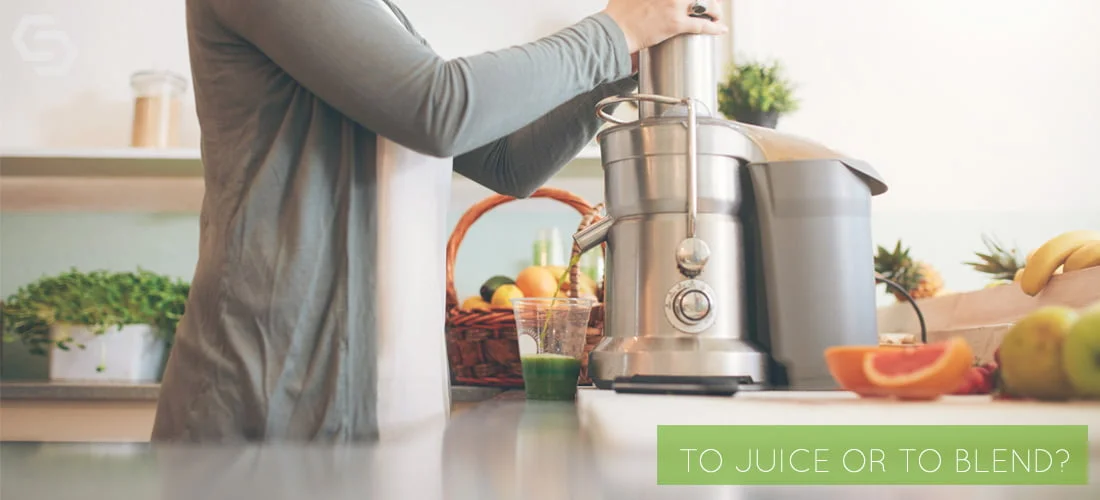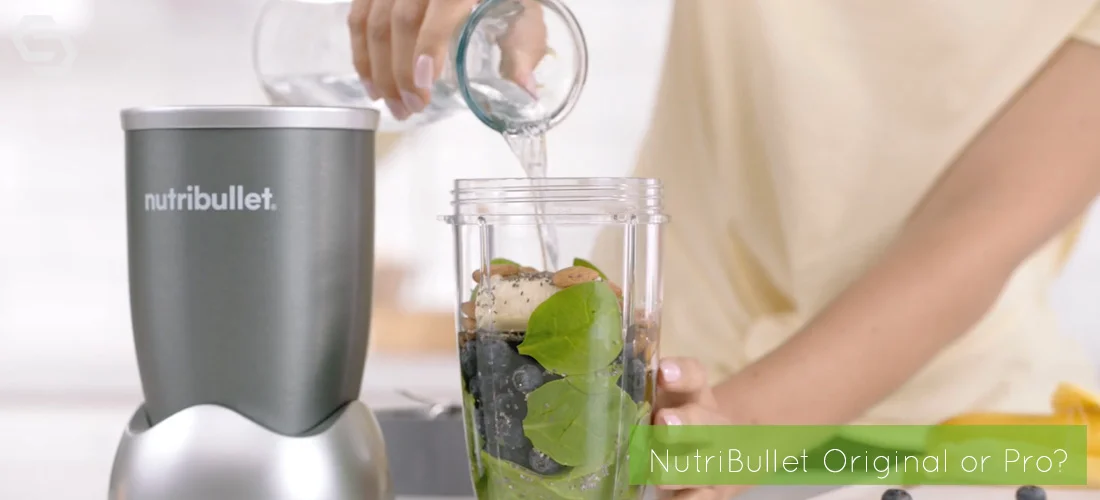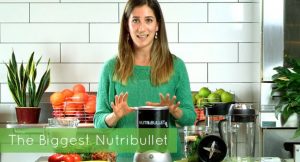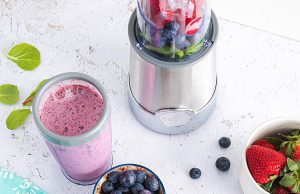It is a common misconception that blending and juicing are the same. This leads to confusion among shoppers who often simply want to reduce the pile of fruit and veg in their kitchen into a healthy glass of liquid as easily as possible. But there are different ways to do so, and it is important to know what they are so that you can make the best choice for yourself.

To Juice or to Blend – What’s the Difference?
Blenders and juicers are two very different beasts with two quite different purposes. Yes, they both process tasty fruit and veggies into a delicious, nutritious drink, but the way they do it and the end result are not the same at all.
A juicer separates the fiber from the rest of the fruit or vegetables. This leaves only the juice for you to drink. The remaining fiber pulp is discarded. This means that you can pack more fruit or veggies per cup, and you get all your vitamins and nutrients in the most easily digestible form.
A blender processes the whole fruit or vegetable, including the fiber. This makes a thicker drink (usually called a smoothie) which takes longer to digest. You still get all the nutrients, but they are released more slowly. This satisfies your appetite and leaves you to feel fuller for longer. See our Ninja vs. Nutribullet comparison guide see these blenders in action.
Juicing vs. Blending – Which is Better for Your Health?
Many blending enthusiasts will tell you that juicing is wasteful, while keen juicers will argue that it is the best possible way to get all the nutrients you need. The truth is that there is no right answer; both methods of processing have benefits and drawbacks, and both have their place in a healthy kitchen. Read on to discover some of the benefits of each.
The Benefits of Blending
No Waste
A blender processes everything you put into it; there is no fibrous pulp to be thrown away at the end. If you are worried about the ‘waste’ when using a juicer, then a blender might feel more comfortable.
Slow Release Energy
The fibre in the drink slows down digestion so that energy is released slowly and evenly. This prevents sugar highs and lows and means that you will feel full for longer after drinking it.
Aids Digestion
The fibre from fruits and vegetables works its way through your digestive system, acting like a broom that sweeps it clean. This helps to remove toxins and encourages regular elimination.
Types of Blender
Jug Blender
A sturdy jug blender works well for general kitchen use and makes great smoothies. Cheaper models might not blend harder veg or thoroughly smooth out crunchy seeds and nuts, but a simple jug blender will do a great job on soft fruits, veg, yogurt, nut butter, honey, and other soft ingredients. They are large enough for a good quantity of ingredients, so they are great if you need to make smoothies in bulk.
Perfect for: large families, bulk blending
For overall versatility, it’s hard to go past the Vitamix Explorian. Featured in our Vitamix vs. Ninja comparison, this blender excels at most things, from smoothies and hot soups to nut butter and sorbet.
Single Serving Blender
The single-serving cup blender has become very popular over the last few years. Perhaps the most well-known is the Nutribullet blender, though similar designs are available from many other leading kitchen brands.
The selling point of these blenders is the detachable lidded cup or flask. The smoothie ingredients are added directly into the cup, which attaches to the blades of the blender. Once your drink is ready, you simply detach the blades, add the lid, and you’re ready to go. Most bestselling designs come with at least two cups or flasks.
As seen in this nutribullet 600 vs. 900 guides, they are fast, efficient, and incredibly simple to use.
Perfect for: busy singles or couples, blending on the go.
The Benefits of Juicing
Fast Absorption
When you extract the juice from your fruit and veggies, you leave all of the indigestible fibrous pulp behind. The vitamin and mineral-packed juice is easily absorbed by your body, so the goodness goes straight to where you need it.
Pack in More Goodness
The juicing process removes a lot of the bulk from your drink, so you can pack the vitamins and nutrients from a lot more fruits and vegetables into the same-sized glass.
Easy Digestion
The liquid content of the juice is easy on your digestive system because the fiber has been removed. If you have digestive problems, then this can be a great way to give your system a break without missing out on any essential nutrients.
Types of Juicer
Centrifugal Juicer
A centrifugal juicer extracts the juice with a spinning metal blade which presses the contents against a strainer. The juice drains off into a waiting container, leaving the pulp behind for disposal.
The low price centrifugal juicers mean that they are the most popular type on the market. They do the job well enough but do have some drawbacks. The heat of the spinning blades destroys some of the nutrients in the juice, so they are not the best choice for anyone who plans to start juicing primarily for health benefits.
Perfect for: bargain hunters; those trying out juicing for the first time
Cold Press or Masticating Juicer
The masticating juicer works by pressing and crushing the ingredients to remove the juice. Also known as slow juicers because of the longer juicing time, they are extremely efficient at extracting the juice and retaining the all-important nutrients.
Despite being generally regarded as superior, slow juicers are less popular than centrifugal juicers. They are larger and more expensive to buy, so they are more suitable for dedicated juicers who are keen to get the best possible health benefits from their juices.
Perfect for: nutrition-packed juice, dedicated juicers
To Juice or To Blend?
The juicer vs. blender debate continues to be a bone of contention among healthy eaters. Like so many other great debates, there really is no one correct answer that will suit everyone.
You might choose one over the other based on specific concerns about nutrition or digestion, a limited budget, or a simple preference for one type of drink over the other. But a well-equipped kitchen could easily house both a juicer and a blender and enjoy all the benefits of both.





